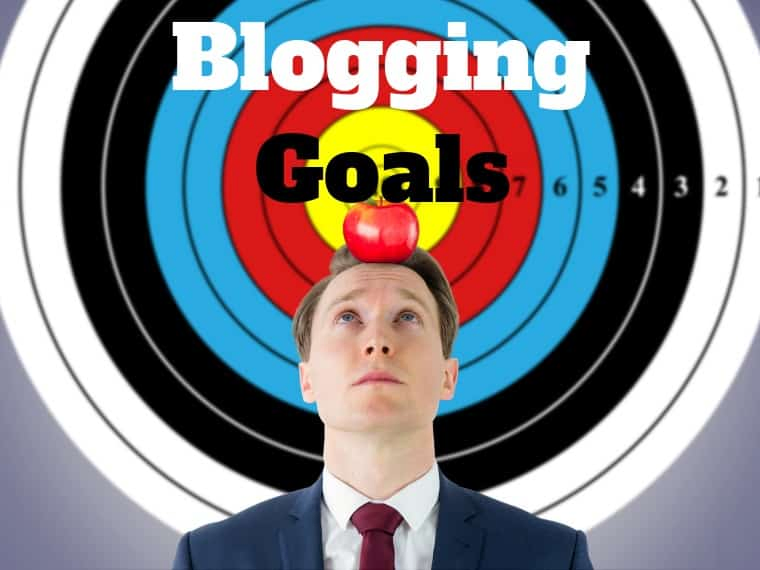SBO Team
Blogging isn’t just a job – it’s a passionate field that requires diligent effort and self-motivation for success. But what really sets your very own blog apart from the successful ones? The answer is plain, direct, and can be traced back to whether or not you have learned how to set blogging goals correctly. So, to ask a rhetorical question, are they really that important?
To answer that, consider the 70 million blog posts being published monthly on WordPress alone, which powers close to 35% of the internet. What sets your site apart from the rest and is yours truly unique? To answer that, let’s get down to business and start learning how to set your blogging goals.
Table of Contents
How to set blogging goals
Now the big problem is not just goal setting, but setting appropriate goals for blogging, but fear not; setting blog goals is way easier than it sounds. You just have to know where to start and have a basic but flexible, structured format. With that in place, you can tweak as needed and even integrate new plans as you proceed forward.
 You might also like: Blog hosting
You might also like: Blog hosting
Identify what needs work
Your blog needs attention and there will be tons to do at the beginning. At first, it may seem like a daunting task to achieve your ambitions of creating a great blog, but upon closer analysis, you find that they can be categorized and broken down into simpler, achievable objectives.
Identify the elements that need work and jump right into the action. If your theme is lacking, then start working on it. If the content requires SEO, then you should start working on that. Don’t let the work pile up – get started right away!
Make a priority list
The best way to set blog goals is to create a priority list. For example, you cannot post content without having finished your theme first. However, a basic theme layout is more than enough to let you start blogging.
Now, the situation will boil down to whether you can multitask or not. For that, you will have to know a simple fact, which is your brain divides resources when doing more than one thing. Just like a computer, your brain’s processing power will be divided over the activities. Hence, it will be all over the place.
Simply put, do one task at a time and complete it efficiently on the basis of priority. This way, you will complete the same amount of work without multitasking and each task will be finished with utmost care and quality.
Be realistic, but never underestimate
Never set unrealistic goals, because all your efforts will ultimately be wasted. Analyze your potential skills, previous track record, and set your goals based on them.
Can you generate blog posts on a weekly basis? Excellent! Write an article every week. Improve on that and move towards a bi-weekly posting schedule.
Bear in mind, there is no need to jump onto a daily posting schedule right away. Quality content takes time and you should use more time if it means the content will be better.
Start small, end big
Every journey starts with one small step, and your blog is no exception. The most terrifying part of any project is the beginning since it seems like there is so much to do. For example, if you search the term “why people don’t start blogs” on Google, numerous searches will show that 99% of them fail.
Focus on one thing at a time
Work on one thing at a time and do it right. This is the foremost word of advice I can give, as I have seen numerous bloggers quit due to pressure. And the saddest part is that this “pressure” is artificial and caused by poor planning. Know your capabilities, give any task at least a rough evaluation, and then set realistic goals for accomplishing it.
Set your priorities
You should have every goal visualized and prioritized before you start. Don’t just improvise as you go, as this will result in an undefined plan with no end game.
Are you blogging for a specific product niche? Then identify the brands for it and start searching for an appropriate affiliate marketing program. Working towards establishing a strong community before everything else? Then start blogging extensively with quality content aimed at resolving viewer queries. Its decisions like these that will make or break your blog.
Set realistic goals
Few things provide the motivation that self-appointed challenges bring to the table. Set your sights high but within your current limits. Once you start achieving the smaller goals, your comfort zone will expand and enable you to achieve more diverse objectives. This is the kind of growth you will be looking for in the long term. And most interestingly, it starts from achieving short term micros which, in the long term, will also help with each bigger goal you set!
Start a calendar
A calendar will help you plan your desired achievements in chronological order. Moreover, it will instill a sense of routine where tasks will have to be worked on a regular basis. And the sweetest part is, the deadlines are all your own! Work at your own pace as you like. With time, you will not only start accomplishing tasks but will learn to create better plans as well.
Reading into these facts will uncover the main reason for owners abandoning projects or simply failing to put effort into them. Moreover, they proceed without a proper strategy, which ends up wasting their efforts. So, make a proper plan, set your goals, and start working towards them. Brick by brick, your blog will start taking the shape you have envisioned.
Creating long and short term goals for your blog
Once you have a basic plan and domain knowledge about your target niche, it’s time to start setting long- and short-term blogging goals. Differentiating them is vital for planning an effective, result-oriented strategy.
The easiest (and most effective) way to set up blog goals is to follow the SMART strategy. Put simply, each goal should be specific, measurable, achievable, results-focused, and time-bound. Let me break each aspect down:
- Specific: Clearly define your blog writing goals. The strategy, implementation, and deliverables should all be clearly elicited. For example, you wish to update the SEO of your blogs. For this task, you will generally set a specific deadline, estimate time for each blog, and then start editing. Once the Yoast plugin (if you use this) gives you the green light, you are good to go.
- Measurable: Focus on breaking down your blogging elements into measurable units. For every goal, there should be measurable units that will help you understand how to achieve them. If you are aiming for 100,000 visitors in a year, then you will need a better theme, SEO, and infographics. Why you may ask? An outdated theme will be slower, resulting in site abandonment. Infographics increase the average traffic by 12% and blogs with them boast 650% higher engagement. And the first 5 searches on the 1st page of Google account for almost 67.60% of the clicks. With these statistics and data, you know why your identified issues are important and the results they will generate when accomplished properly.
- Achievable: Most bloggers quit within the first 3 months because they have set unachievable goals. You cannot monetize your site within the first month and can most definitely not be ranked on the 1st page of Google in the same timeline. However, these can be your long-term goals, which will be achievable through short-term ones, such as generating long-form content, a well-placed keyword strategy, blogging frequently, and so on.
- Results-focused: Your blogging goals should be aimed to produce results instead of being ambiguous. Writing legible content is not the same as optimizing it for a specific niche. For that, you will need a proper keyword strategy for ensuring it ranks first against relevant keywords. When you set your goals to achieve a specific result, they can be modified at every iteration to produce better results the next time.
- Time-bound: Setting deadlines is vital for success. Let’s not lie to ourselves – the goals you merged will not really reduce the quantity but will only complicate things further. Blogging goals can almost never be completed without deadlines as they either get pushed further down the pipeline or are merged with more goals under the façade of saving time.
Having time-bound goals allows you to develop routines where specific time has to be dedicated to the blog. This, in the long run, allows you to not only develop proper strategies but to also complete them in the given time.
Setting goals for first month

These first-month blogging goals will mostly include:
- Selecting a website theme.
- Getting started with posting content.
- Identifying the target audience.
- Creating social media accounts (Twitter, Facebook, and Instagram for starters) for the blog.
- Promoting blog posts on their social media handles.
- Starting networking with similar bloggers in the niche.
Setting blog goals for the first year
Your first year blog goals are the truly long-term ones that will need sure but steady work. The blogging goals for the first year can include:
- Setting up the site completely.
- Shifting to self hosting.
- Generating a short blog of 500 words or fewer every other day for your site.
- Developing infographics with your content.
- Having a proper website theme in place.
- Doing a guest post with a backlink every week.
- Monetizing your site.
- Participating in at least one affiliate marketing program.
Examples of SMART blog goals to set
The following SMART goals will help you get your blog up and running and with both short- and long-term goals in mind:
1. Long form blog writing goals

The answer is actually quite simple: long-form content packs more value for the punch. Google has repeatedly been dropping hints that its algorithms value long-form content. This has become even more evident from Google’s BERT update in late 2019. Longer content allows you to add information to the blog without restraint, thus allowing you to increase the “value” it can present to the reader. Moreover, it does not restrict you from fully expressing yourself when writing.
The updates in natural language processing from Google’s end means it will actually recognize how helpful your content is. The more helpful it is, the more views and traffic it will generate. And with that, your authority and search engine rankings will shoot up.
Go the extra mile and make writing long-form content for your audience a priority.
2. Set a goal to write one post weekly
If you want your blogging efforts to bear fruit, then you will have to work for it. And it is not so hard either. As mentioned earlier, there are sites generating hundreds of thousands of views with just a weekly post. This will allow you to get into the flow of things and generate quality content without taking on too much pressure.
Once you have settled into the flow of things, you can write long-form content featuring in-depth insights and knowledge. You can take things at your own pace from here and try to double your blog posting goals with a bi-weekly posting schedule.
Word of advice though: never compromise on quality. Content is king, and the king is truly legitimate only if recognized by his subjects. Let the quality of your blogging post do the talking.
3. Shift to self-hosting
I highly recommend making a shift to self-hosting a blog goal (if you have not already) towards which you slowly but surely work. The limits such as monetization and feature restrictions are sooner or later bound to catch up as your blog grows and establishes its own community. Migration comes with its own problems, so it is better to set the foundation right by investing your resources smartly.
So, why self-hosting, you may ask? Well, for starters, you own that site, not someone else. It provides complete control over the site along with the ability to modify things as you please. The site has a much lower loading time due to better hosting. About 40% of users expect a web page to load within 2 seconds and 40% will abandon if it takes more than 3 seconds. This just goes to show how significantly loading time can impact your traffic.
You can customize the site with your own HTML code, plug-ins, and themes, with the possibilities being endless. You will mostly have access to a support team with your package, who will take care of the settings and technical stuff. To top it off, you get a custom domain, which adds to user trust.
4. Blogging on other sites
Getting link juice is vital to get your SERP rankings up. One of the easiest ways to do this is to start guest posting. The idea is quite simple – you write some quality content for another website. The trick is to make it relevant to their community by appealing to their marketing strategy, community, and other such factors. This will significantly increase the chances of its acceptance.
If the post does get accepted, you will be normally allowed a link back to your site. This is among the most effective of long-term ways to establish backlinks. And it works for both sides: you get a backlink and the guest site gets a blog post!
5. Regularly create infographics
A single picture speaks a thousand words, and infographics bring the same power to your blog post. The brain processes an image approximately 60,000 faster compared to text. This allows you to display concise yet precise information without boring your viewer. They have also been proven to increase traffic straight up by 12%.
A simple blog post with infographics enjoys a whopping 650% more engagement! Viewers are also more inclined to recall visual data rather than textual, meaning your blog post will have a stronger impact on them.
Make achievements to be to learn how to create infographics and create one monthly. When done correctly, they can be a huge asset to your blog.
6. Set a social media goal
Social media is nothing new. However, there are few blogs that use it to its maximum potential. A post with images and infographics can be shared as much as 3 times more on social media apps. Moreover, graphical content gets almost 105% more engagement as compared to simple links. A post with images will also get 150% more retweets and 230% more engagement on Facebook.
The list can go on, but the point is that becoming a social media influencer is a great way to get the word out there about your blog.
Examples of goals for new bloggers
1. Commitment goals
Stay committed to your goals. Your budding blog needs all the attention you can spare. However, there is no need to overdo it as some new bloggers do.
List down a set time that you will dedicate towards the blog on a daily basis. It doesn’t matter if you do not complete a whole task; what matters is whether you managed to do a bit of it correctly. Work your way from there, after establishing a proper routine.
2. Theme matters
Getting your theme game on point is crucial since the first thing your viewers see is the general look of the site. About 65% of the people are visual learners, meaning they rely more on visual stimuli than textual. And your site will be judged on the basis of its theme.
3. Audience goals
It is good to focus on a specific niche and target audience since it allows you to produce spectacular, objective-oriented results. However, it is also good to start working on more than just one niche. Diversify your target audience by blogging on more (related) topics or searching for sub-topics within the niche.
For example, if you are writing about computer hardware, delve a little into mobile hardware as well. Not only will it allow you to expand your domain, but it will also help in drawing in more traffic.
4. Start answering FAQs
Paying attention to what questions are being asked about your target niche is something that many new bloggers fail to do. Answering these FAQs should be a top priority since it allows you to directly link with the community. When your audience notices that your blog actually answers their queries, they will start frequenting it. And that is a really nice way you can connect with your community and generate stable traffic.
5. Get your community involved
Make one of your ambitions to be to generate content that will get your target audience talking. Provide them with the facts and don’t shy away from giving your opinions. However, the trick lies in engaging them in a conversational manner. Invoke their response by asking their opinion on it. Conduct a poll to weigh in their opinions. By giving them an opportunity to present their views, you will draw in traffic not just from your community but those that have opposing opinions as well.
6. Target trending topics
You heard me. If you want to stay relevant, you will have to cover the trending topics. New smartphone on the market? Write a review. A shift in the political scenario? Give your opinion. Breakthrough in medical science? Generate an in-depth report covering its benefits. If it is happening in your niche, then you must cover it. Your audience will simply love your content and will click on your site link to read it.
Conclusion: getting the most out of your goals
While starting a blog may seem daunting, it’s the steady effort and effective planning that actually makes it work. SMART goals for bloggers ensure that things are implemented effectively and appropriately while reducing overwhelm and giving direction. Dividing them into micros and macros based on long- and short-term deliverables make it all the easier to manage and achieve them. With a proper blogging strategy in place, you can be sure to meet set objectives and see your blog steadily gain the traffic and repute that it deserves.
Did you have any questions about blogging goals after browsing this article? Let us know in the comments!
Greg Narayan blogs at DearBlogger when he shares down to earth WordPress advice and quick solutions to common issues each morning. He has recently shifted his efforts to helping Indian bloggers find the best tools, services, themes, and web hosting in India.
If that sort of stuff would interest you, check it out!
Related articles:
Did you know that there is more carbon dioxide in our atmosphere today than any time in history?
We take pride in reducing our carbon footprint with the #1 Green Hosting Platform
GREENGEEKS
Their servers operate on 100% Wind Energy, so you can help the climate for a super affordable price (through us) while benefiting from the best features a hosting platform has to offer.
You’ll even get a FREE domain name with them!
Help save the planet. Get your web hosting with GreenGeeks now.



Definitely great tips here Greg! If people follow this guide to starting a blog and utilize Karen’s step by step tutorial they will accomplish what many bloggers don’t… get a successful start! Countless others never reach the final step and quit before their breakthrough! This post made me think back to when I started blogging.
Step 1 reminded me of how stuck I was deciding what to write about. Originally I had a few ideas that flopped because I’m not one of the Kardashians! What happened next is I practiced what you suggest here… tried something else and put out what the internet needs.
Step 2 was when I found you and Dear Blogger via a Google search… I was so frustrated and didn’t know where to begin. Still so thankful for your support and pointing me to WordPress, Hostgator, and your tutorials!
Step 3: The WordPress installation was easier than getting going! I still remember how hard it was for me to navigate building my website. Your tutorials definitely saved me and got me going successfully! Seems like so long ago now!